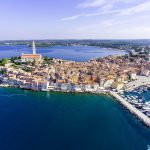We all know where one of the most popular spots with tourists and locals alike – Zrinjevac park – is located, but do you know whom it was named after?
Even though there are many busts at Zrinjevac Park, up until a few days back, there was no sign of the man the park was named after – Nikola Šubić Zrinski. Even though the initiative to add his bust to the park has existed since 1879, no concrete steps were made until last year, ZG Express reports.
The bust, made by sculptor Vladimir Herljević, was placed in front of the building of the Croatian Institute of Sciences and Arts, facing the park.
But do you know who Nikola Šubić Zrinski was and why he is famous in Japan?
Nikola Šubić Zrinski (1508 – 1566) is one of the most famous Croatian noblemen and an important figure in Croatian and Hungarian history. He was a distinct soldier, who fought against the Ottoman forces and participated at the siege of Vienna. He and his 400 men saved the imperial army before Pest, so he was appointed ban (viceroy, a historic title, similar to governor) of Croatia.

Nikola Šubić Zrinski by Oton Iveković
He won a series of victories over the Ottomans, culminating in the battle of Babócsa and defeated the Ottomans at Szeged.
The most famous event connected to Zrinski happened in 1566 when his small force (2,300 soldiers) spent an entire month heroically defending the little fortress of Szigetvár against a huge Ottoman army (102,000 soldiers), led by Suleiman the Magnificent in person, who had died from a cerebral hemorrhage one day before the Ottomans won the war.
Nikola Šubić Zrinski died in a heroic sortie together with his fellow knights and his actions were praised throughout Europe. He was even dubbed the new Leonidas.
Although the battle was an Ottoman victory, it stopped the Ottoman push to Vienna that year. The importance of the battle was considered so great that the French clergyman and statesman Cardinal Richelieu was reported to have described it as “the battle that saved civilization.” The battle is still famous in Croatia and Hungary and inspired both the Hungarian epic poem The Siege of Sziget and the Croatian opera Nikola Šubić Zrinski.
There is also an order awarded to Croatian of foreign citizens for acts of heroism – The Order of Nikola Šubić Zrinski. It is the eighth-ranked honour order given by the Republic of Croatia.
Fun fact: due to his heroic life and samurai death, Nikola Šubić Zrinski is famous in Japan and male choirs often perform an aria from the Nikola Šubić Zrinski opera.
On February 26, 2006 a Japanese choir composed of 1,000 singers conducted by maestro Katsuaki Kozai sang “U boj, u boj” in Tokyo. This was a record-breaking event for choir singing, with more than 10,000 people in attendance.
It is believed that the song was brought to Japan by Croatian sailors (then within the Austrian-Hungarian army) after the end of the WWI. While retreating from the Russian Far East front in Siberia, their ship was stranded on the Japanese coast in Kobe, near Osaka, where they taught the locals how to sing “U boj, u boj”
Watch the choir sing in Japan
https://www.youtube.com/watch?v= uKYRPzc_3M8
as well as in Zagreb’s Oktogon










